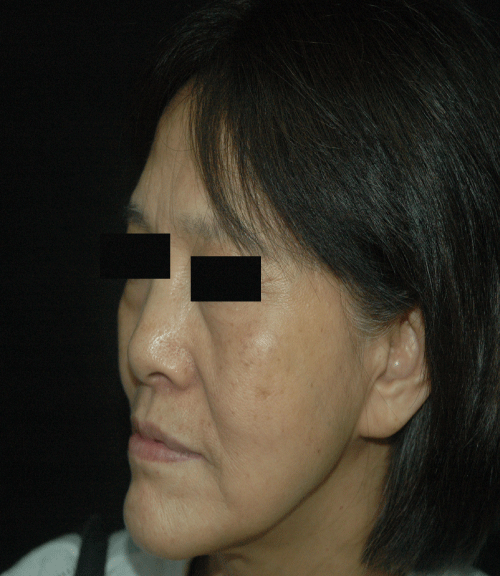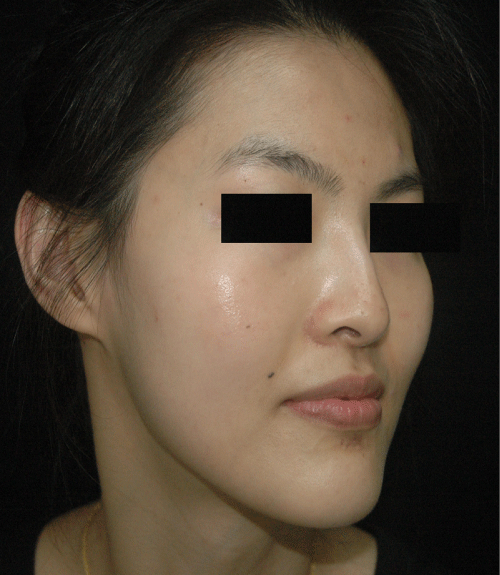
Short Communication
Austin J Dermatolog. 2014;1(4): 1020.
Treatment of Familial Nevus Fusco-caeruleus Zygomaticus with Q-switched Alexandrite Laser
Zuo YG* and Wang JB
Department of Dermatology, Chinese Academy of Medical Sciences, China
*Corresponding author: Ya-Gang Zuo, Department of Dermatology, Peking Union Medical College Hospital, Chinese Academy of Medical Sciences, No 1, Shuaifuyuan Hutong, Dongcheng District, Beijing, China
Received: August 18, 2014; Accepted: September 11, 2014; Published: September 15, 2014
Keywords
Nevus Fusco-caeruleus zygomaticus; Familial; Q-switched alexandrite laser
Abbreviations
NFZ: Nevus Fusco-caeruleus Zygomaticus; FNFZ: Familial Nevus Fusco-caeruleus Zygomaticus; ABNOM: Acquired Bilateral Nevus of Ota-like Macules; Nd:YAG: Q-switched Neodymium: Yttrium- aluminum -garnet; QSAL: Q-switched Alexandrite Laser; PIH: Post-inflammatory Hyperpigmentation
Nevus Fusco-caeruleus zygomaticus (NFZ) is characterized by the bilateral occurrence of small, circumscribed, speckled, or confluent blue-brown pigmentation on typical locations of malar regions or temples, upper eyelids and root and alae of the nose [1]. It is very common in Asian. NFZ is also termed as nevus of Hori and acquired bilateral nevus of Ota-like macules (ABNOM) [2]. Recently, familial NFZ (FNFZ) was reported in a Chinese family, comprising 7 affected individuals out of 25 family members spread over four generations, in accordance with an autosomal dominant mode of inheritance [2].
The following lasers have been introduced with various clinical outcomes for the treatment of NFZ: the Q-switched neodymium: yttrium-aluminum -garnet (Nd: YAG) laser [3,4]), the Q-switched ruby laser [5], and the Q-switched alexandrite laser (QSAL) [6,7]. Our previous study and another report [8,9] showed that QSAL is effective and safe for the treatment of NFZ in Asian people. Here, we report a case of FNFZ with two affected individuals in two generations who were treated successfully with QSAL.
A 22-year-old female presented with small brown speckled spots on the bilateral zygomatic area (Figure 1). The lesions appeared when she was 18 years old, and grew darker with age. Such spots usually become apparent after sun exposure, but they do not usually vary in size. The subject did not take any medicine for a long time and did not receive any previous treatments for the lesions. Her mother, a 54-year-old female, had similar lesions on similar locations and similar ages of onset (Figure 2). The diagnosis of FNFZ was made and the two patients were treated with QSAL with a spot size of 3 mm, pulse duration of 100 ms, and a fluence of 7-8 J/cm2. They were advised to avoid sun exposure and apply sun protection cream after treatment. Both of them were treated for 3 sessions at intervals of 2 or 4 months and achieved a complete clearance without hyperpigmentation and hypo-pigmentation (Figure 3). Two years later, the patient was without relapse.
Figure 1: Small brown speckled spots on the bilateral zygomatic area in a 22-year-old female.
Figure 2: Similar lesions on similar locations a 54-year-old female (the mother in the family).
Figure 3: A complete clearance without hyperpigmentation and hypopigmentation after 3 successive Q-switched alexandrite laser treatments in the younger patient.
Clinically, NFZ differs from nevus of Ota in the following aspects: NFZ is present in a symmetrical bilateral fashion, has a late onset in adulthood, and lacks mucosa and sclera involvement. In contrast, nevus of Ota is usually unilateral, occurs in the first year of life or during adolescence, and involves the conjunctival, oral, or nasal mucosa, as well as the tympanic membrane [2,3].
Although NFZ has a high incidence in the Chinese population, affecting about 0.8% of the Asian population, with a significant female predominance [1,9], FNFZ is generally rare. In 2012, a case of FNFZ involving sclera was reported in a Chinese family [2]. Our patient showed different type of lesions and did not involve sclera.
QSALs have been used to treat NFZ for a long time, though the clinical response has not been the same. A randomized, double-blinded, split-face, comparative trial, which was performed to evaluate the effect of QSAL treatment for pigmentation in Asians, showed that patients with ABNOM experienced a 35% clearance of their pigmented lesions after a single treatment with a QSAL [6], whereas in the Lam et al. study [8], complete clearance was only seen in 28% of patients after seven treatment sessions. In this report, however, the two patients received complete clearance after three sessions.
Postinflammatory hyperpigmentation (PIH) is common in Asians after QSAL treatment, but the incidence of PIH caused by QSAL was different in different articles. The highest incidence rate of PIH in patients with ABNOM was 75% [6], whereas, in the Lam et al. study [8], PIH was only detected in 12.5% patients [8]. Differences in the complication rate and clinical response may be due to the settings of the laser parameter and treatment intervals [8]. Fortunately, the two patients in our study did not suffer PIH after three treatment sessions.
Limitation
We did not do histopathology for the patients, because they are afraid of scarring caused by biopsy.
Acknowledgement
We thank Mr. Xie WH and Mr. Du RX in our department for their assistance in taking pictures.
References
- Sun CC, Lü YC, Lee EF, Nakagawa H. Naevus fusco-caeruleus zygomaticus. Br J Dermatol. 1987; 117: 545-553.
- Yang B, Li L, Hu N, Li Y, Deng C. Familial nevus fusco-caeruleus zygomaticus. Int J Dermatol. 2011; 50: 858-859.
- Lee WJ, Han SS, Chang SE, Lee MW, Choi JH, Moon KC, et al. Q-Switched Nd:YAG Laser Therapy of Acquired Bilateral Nevus of Ota-like Macules. Ann Dermatol. 2009; 21: 255-260.
- Cho SB, Park SJ, Kim MJ, Bu TS. Treatment of acquired bilateral nevus of Ota-like macules (Hori's nevus) using 1064-nm Q-switched Nd:YAG laser with low fluence. Int J Dermatol. 2009; 48: 1308-1312.
- Park JM, Tsao H, Tsao S. Combined use of intense pulsed light and Q-switched ruby laser for complex dyspigmentation among Asian patients. Lasers Surg Med. 2008; 40: 128-133.
- Wang CC, Chen CK. Effect of spot size and fluence on Q-switched alexandrite laser treatment for pigmentation in Asians: a randomized, double-blinded, split-face comparative trial. J Dermatolog Treat. 2012; 23: 333-338.
- Lam AY, Wong DS, Lam LK, Ho WS, Chan HH. A retrospective study on the efficacy and complications of Q-switched alexandrite laser in the treatment of acquired bilateral nevus of Ota-like macules. Dermatol Surg. 2001; 27: 937-941.
- Wang HW, Wang JB, Liu YH, Zuo YG, Jin HZ, Jiang GT, et al. [Clinical efficacy of Q-switched Alexandrite laser for pigmentary skin diseases in 4656 patients]. Zhongguo Yi Xue Ke Xue Yuan Xue Bao. 2006; 28: 202-205.
- Wang BQ, Shen ZY, Fei Y, Li H, Liu JH, Xu H, et al. A population-based study of acquired bilateral nevus-of-Ota-like macules in Shanghai, China. J Invest Dermatol. 2011; 131: 358-362.


